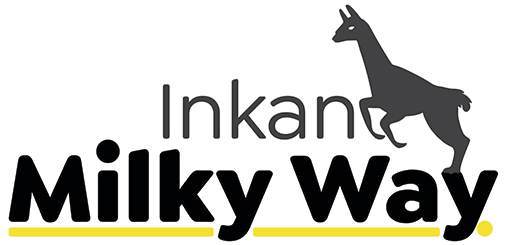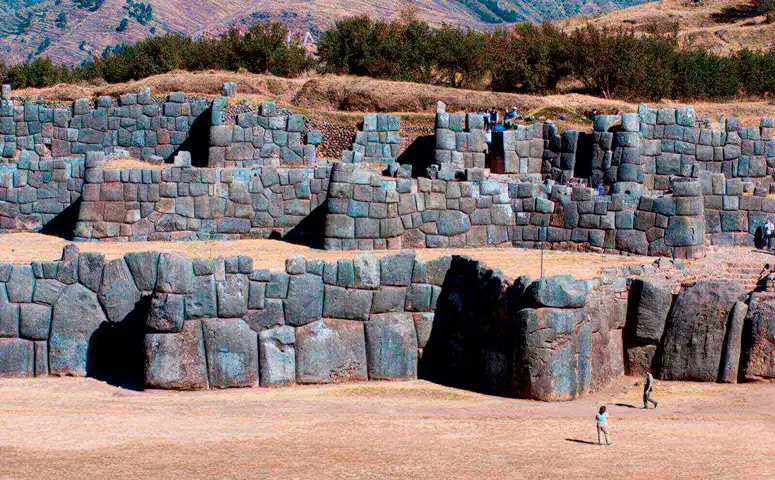
Few countries in the world boast such a vast and diverse archaeological legacy as Peru. In its ever-changing landscape of coast, forest, and mountains, ancient civilizations built cities, temples, fortresses, and even agricultural experimentation centres, using stone, clay, and adobe blocks.
This immense historical and monumental heritage extends far beyond Inca constructions like Machu Picchu and Saqsaywaman. Other ancient cultures have left their mark on a country that is regarded as one of the world’s civilising centres.
Get ready to explore, discover, and “re-live” thousands of years of cultural development at the 20 archaeological sites we’ve selected for you. Keep them in mind when planning your next adventure to Peru. By visiting them, you’ll connect with the historical roots of this ancient nation.
Contents
Machu Picchu
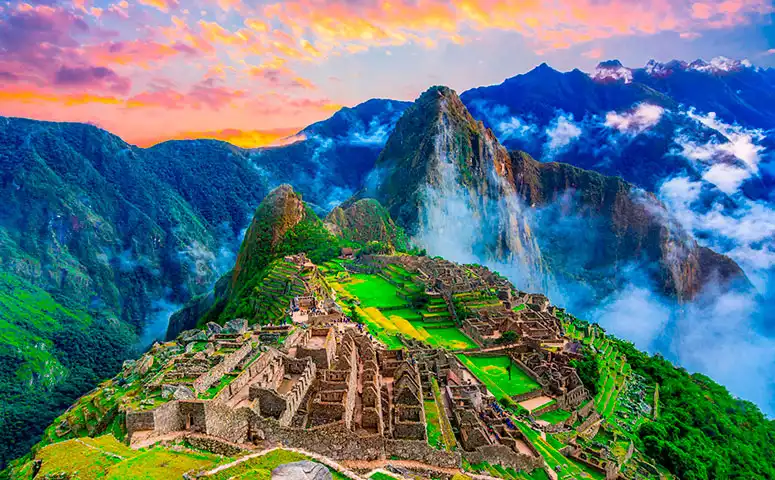
It is the archaeological and tourist icon of Peru and the dream destination for millions of travellers. Whether you’re visiting for the first time or have already been and long to return, this architectural marvel nestled among mountains, which serves as a sanctuary of nature, is waiting to impress (or continue impressing) you with its magnificence.
Built in the 15th century during the reign of Inca Pachacútec, Machu Picchu was designed as a retreat for the Cusco ruler. Like other pre-Hispanic cities, this wonder of the world, located at 2,430 m a.s.l., also served a religious purpose, as evidenced by the existence of the Intihuatana.
During the colonial period, the citadel fell into obscurity, perhaps due to its distance from Cusco and its location in a transitional zone between the Andes and the Amazon. This veil of indifference was lifted in 1911 when explorer Hiram Bingham arrived at the Inca jewel located in the province of Urubamba.
The publication of his “discovery” in National Geographic marked the “awakening” of Machu Picchu, the Inca llaqta designated as a UNESCO World Heritage Site in 1983 and classified by the Peruvian government as a historic sanctuary.
- Location: Machu Picchu district, Urubamba province, Cusco.
- Opening Hours: Monday to Sunday from 8:00 to 16:15.
- Prices: Check the costs for the various routes on the platform Tuboleto.cultura.pe.
Chan Chan
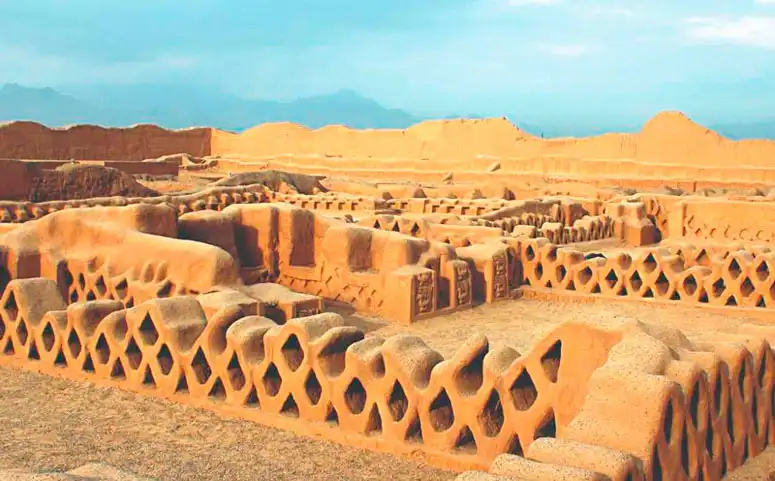
It was the capital of the Chimú kingdom, one of the great pre-Hispanic civilizations of northern Peru. Spanning 20 km², it is considered the largest adobe city in Latin America and one of the most significant in the world for its importance between the 12th and 15th centuries.
It is estimated that between 60,000 and 100,000 people lived in this political, economic, cultural, and commercial centre. The city features multiple walled complexes housing workshops and temples, adorned with reliefs of geometric and zoomorphic figures (birds and fish).
Designated a UNESCO World Heritage Site, Chan Chan—located on the outskirts of Trujillo, the capital of the La Libertad region—invites you to discover the art, worldview, and way of life of the Chimú people, one of the cultures that emerged in pre-Hispanic Peru. It is a destination rich in history, culture, tradition, and nature.
- Location: 4.5 km from the Historic Centre of Trujillo, on the road to the Huanchaco beach resort.
- Opening Hours: Monday to Sunday from 9:00 to 16:00.
- Prices:
- Adults: S/ 10.00
- Higher education students and seniors: S/ 5.00
- Children (school-age): S/ 1.00
Sacsayhuamán
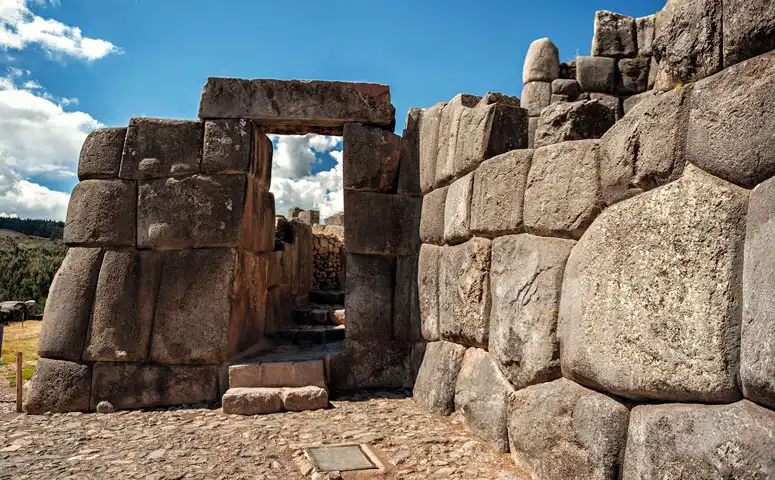
It is one of the most representative archaeological monuments of the Andean world. Its megalithic walls, natural surroundings, and design in the shape of a puma (with the body represented by the urban geography of Cusco) showcase the complementary nature and planning of the Inca civilization.
During the Tawantinsuyu, Sacsayhuamán served as a central hub for religious rituals and significant celebrations, in addition to fulfilling military functions (it is believed to have been a fortress). As you explore, be sure to admire the famous sliding stones (petrified volcanic lava) and the chinkanas (tunnels).
Sacsayhuamán is the main area of the archaeological park that bears its name. Within its nearly 3,000 hectares, you’ll find 96 points of interest, some of great importance such as Q’enqo, Tambomachay, Kallachaca, and Patallaqta, among others. Today, it serves as the main venue for Inti Raymi (the Festival of the Sun).
- Location: North of the Historic Centre of Cusco, approximately 2 kilometers away.
- Opening Hours: Monday to Sunday from 8:00 to 17:00.
- Prices: Entry to Sacsayhuamán is included in both options of the Cusco Tourist Ticket.
- Foreigners: S/ 130.00 (full ticket) / S/ 70.00 (partial ticket).
- Peruvians: S/ 70.00 (full ticket) / S/ 40.00 (partial ticket).
Caral
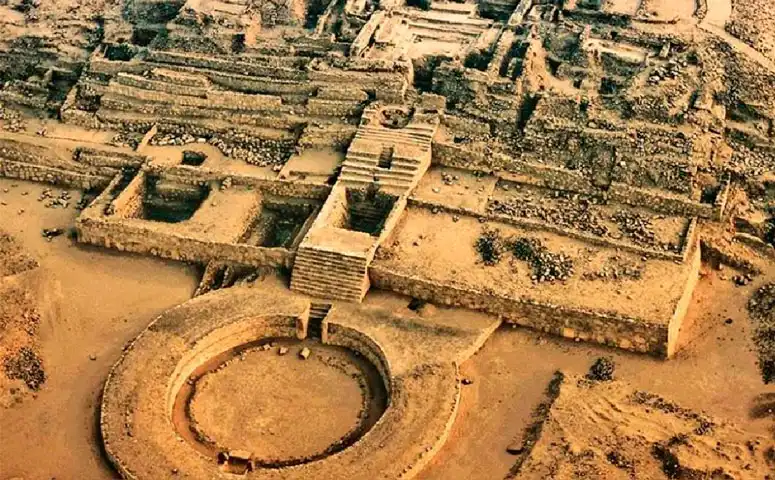
It is the oldest urban settlement in America. With an estimated age of around 5,000 years, Caral is the result of a civilizational process that emerged autonomously among Andean communities during the Late Archaic period. This dynamic gave rise to an organizational, socioeconomic, and political system.
The Sacred City of Caral, located in the district of Supe (Barranca province, Lima region), boasts 32 monumental structures, including pyramids, ceremonial spaces, residential areas based on social status, and designated zones for artisanal and agricultural production.
- Location: It is situated 207 kilometers north of Lima, in the district of Supe in Barranca province.
- Opening Hours: Monday to Sunday from 9:00 to 17:00.
- Prices:
- Adults: S/ 11.00
- Higher education students: S/ 4.00
- Children (school-age): S/ 1.00
Kuélap
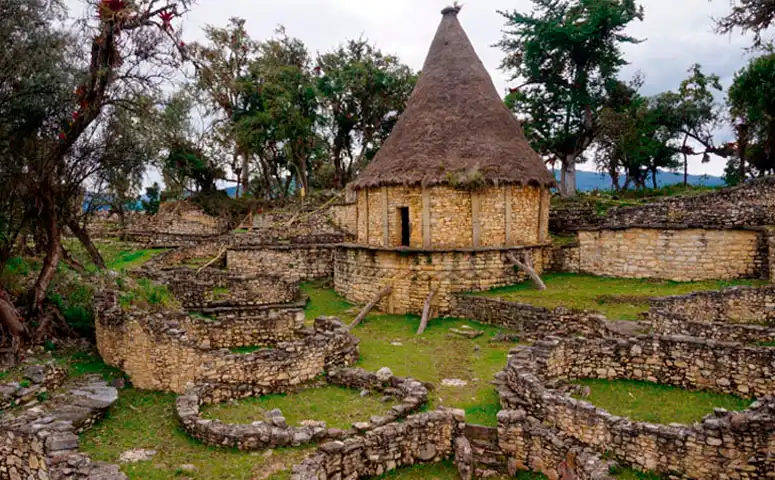
Limestone walls reaching heights of 20 meters surround and protect 500 circular stone houses. This is the monumental legacy of the Chachapoyas, a pre-Hispanic people who settled in the lush mountains of the Luya province in the Amazonas region.
In this fortified city, the Chachapoyas resisted the might of the Incas. The Cusco armies could not conquer Kuélap. Its narrow and steep access points served as a deadly trap for invaders, allowing the Chachapoyas to withstand the siege until their food supplies ran out.
When you visit the archaeological site, pay close attention to El Tintero, a circular tower standing 5.5 meters tall, and the Castillo, a rectangular structure that is believed to have been a ceremonial centre. Another point of interest is El Torreón, which majestically rises to 7 meters.
Throughout your journey, your eyes will feast on stunning panoramic views of the mountains stretching to the horizon. Your adventure in Kuélap will be even more intense if you take the cable car inaugurated in 2017. The boarding station is in Nuevo Tingo, 50 kilometers from Chachapoyas (2,483 m a.s.l.), the capital of Amazonas.
- Location: Tingo district, Luya province, Amazonas region. Accessible by road from Chachapoyas. There is also a combined route (road-cable car).
- Opening Hours: Monday to Sunday from 9:00 to 14:30.
- Prices: Tickets can be purchased on the Tuboleto.cultura.pe platform.
- Foreigners: S/ 30.00
- Peruvians and citizens of the Andean Community of Nations: S/ 20.00
- Minors: S/ 2.00
Nazca
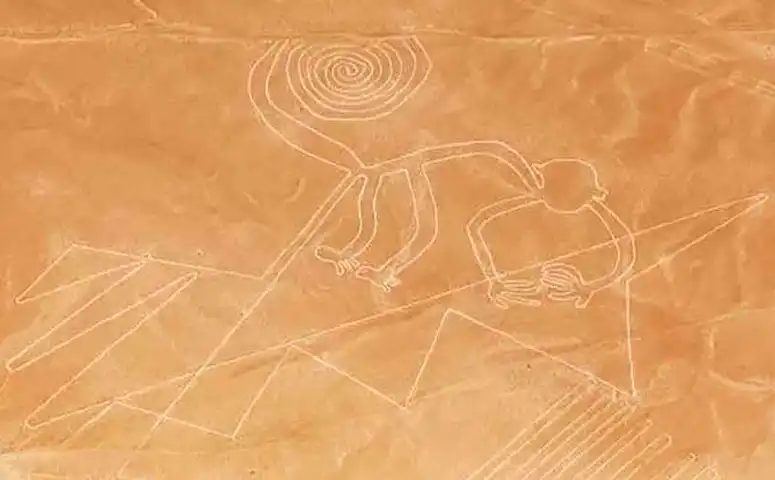
And you see a hummingbird, a condor, a monkey, a dog, a spider, a whale, a tree, and even a humanoid they call the astronaut. And you see them from above, from a small plane flying over a pampa sliced by the asphalt of the Panamericana Sur. And you see them and wonder: who made them and why?
This is the mystery of the gigantic Nazca Lines (in the province of the same name, Ica region), the magnificent representations of animals, plants, and geometric shapes traced on the plains of Jumaná and San José, believed to have astronomical and religious purposes, according to various theories.
Yet, questions about their origin and function remain to this day. This fuels the curiosity of travellers who fly over the area to admire the geoglyphs that were etched into the arid skin of the desert by the Nazca culture.
- Location: Tourist planes flying over the Nazca Lines take off from María Reiche Neuman Airport, located at kilometer 447 on the Panamericana Sur. There is also a viewing platform at kilometer 425.
- Opening Hours: Monday to Sunday. Flight times vary by airline, but generally take place between 7:00 and 16:30.
- Prices: Prices vary depending on the season and the operating company. Typically, ticket prices range from $80.00 to $100.00. If you want to visit the viewing platform to see three figures, it will cost less than $5.00.
Ollantaytambo
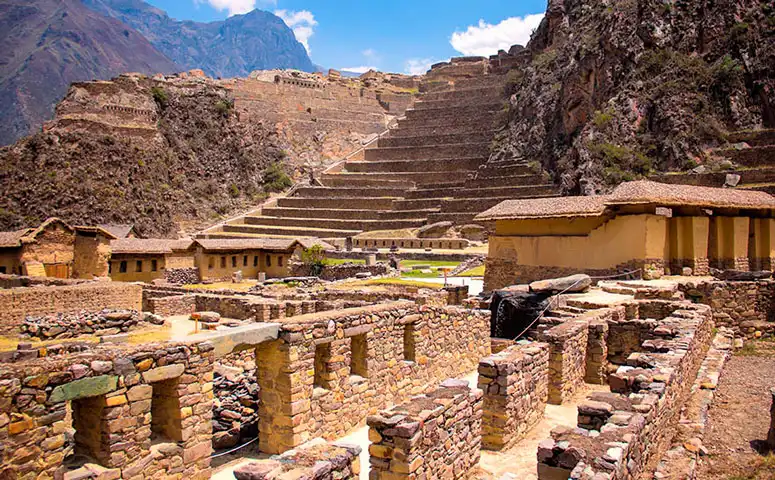
It rises like a stone giant in the Sacred Valley of the Incas. Its temples, homes, terraces, and other structures are outstanding examples of Inca architecture, revealing that this archaeological monument served administrative, military, religious, and agricultural functions.
At the top of a hill stands the iconic Temple of the Sun, along with a series of canals and water fountains that, despite the passage of centuries, remain functional. This is evidence of the hydraulic knowledge of the “children of the Sun.”
The archaeological park is not the only attraction in Ollantaytambo; the entire town is a refuge of the past. So take some time to explore the urban heart of this district in the Urubamba province (Cusco region), which is a mandatory stop on the way to Machu Picchu, whether by train or via the Inca Trail.
- Location: 60 kilometers northeast of Cusco. Accessible by road.
- Opening Hours: Monday to Sunday from 7:00 to 18:00.
- Prices: Entry to Ollantaytambo is included in both options of the Cusco Tourist Ticket.
- Foreigners: S/ 130.00 (full ticket) / S/ 70.00 (partial ticket).
- Peruvians: S/ 70.00 (full ticket) / S/ 40.00 (partial ticket).
Pachacamac
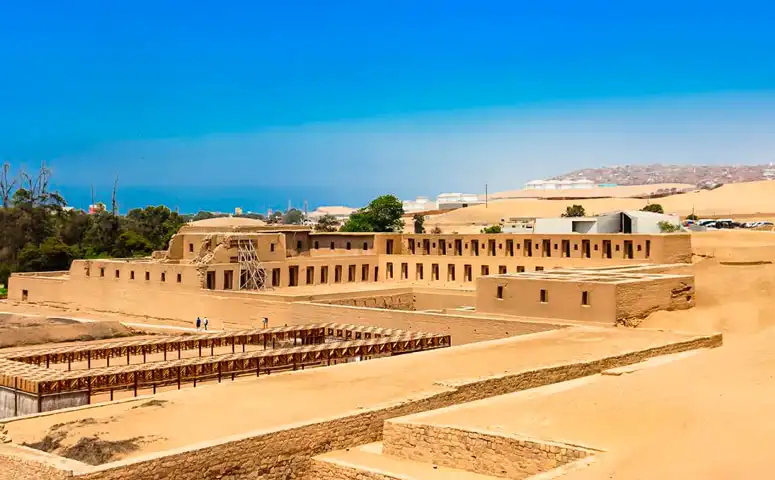
God and oracle of the Andean worldview, Pachacamac’s sanctuary was the most important on the central coast of Peru in pre-Hispanic times. This status continued during the height of the Inca Empire, to the extent that its priests maintained their autonomy and pilgrims continued to honour Pachacamac.
How could they not, when Pachacamac was the “soul of the earth and the one who animates the world,” as his name translates into Spanish? His power was so immense that he could generate earthquakes with a mere movement of his head. Even the “children of the Sun” respected him and sought his counsel.
At the archaeological sanctuary of Pachacamac, you will discover the Temple of the Sun, the Old Temple, and the Urpi Wachaq Temple. Other points of interest include Aclla Wasi, where the women in charge of the cult lived, and the Site Museum, which exhibits various pieces that allow you to learn about the cultural heritage of the Lurín valley (Lima).
- Location: Pachacamac is located in the Lurín district, just 40 kilometers south of the Historic Centre of Lima.
- Opening Hours: Tuesday to Saturday from 9:00 to 17:00; Sundays from 9:00 to 16:00.
- Prices:
- Adults: S/ 15.00
- Higher education students: S/ 5.00
- On the first Sunday of each month, entry to the Site Museum is free for both Peruvians and foreigners with a valid foreign residency card.
Huaca Pucllana
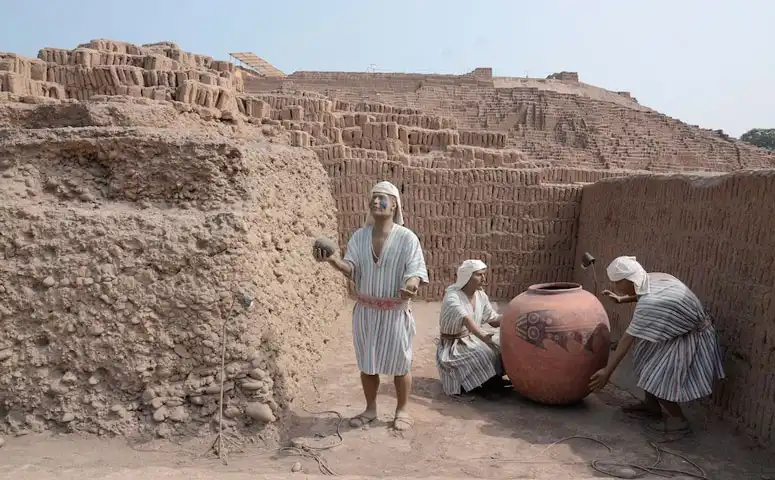
In the modern district of Miraflores, one of Lima’s commercial and tourist hubs, stands a clay and adobe pyramid that evokes the pre-Hispanic past of the Peruvian capital, revealing its ancestral roots often hidden beneath the architectural and cultural legacy of the colonial period.
The pyramid rises over seven stacked platforms and is part of a ceremonial and administrative centre of the Ichma culture (200 A.D. – 700 A.D.). Huaca Pucllana features two distinct areas divided by a structural wall. One area contains deep wells where marine offerings were made to the ancient gods.
The other area of the complex was designated for administrative purposes. Here, you will see small clay structures and adobe houses. Pucllana also contains remnants of the Wari culture, which directly influenced present-day Lima between 500 A.D. and 1000 A.D.
Among the most notable finds is the impressive Señor de los Unkus, unearthed in the first tomb of the ceremonial complex. Its excellent state of preservation has provided valuable insights into funerary practices and the iconography of Ichma textiles.
- Location: Calle General Borgoño, block 8, Miraflores. Approximately 20 minutes from the Historic Centre of Lima.
- Opening Hours: Monday to Sunday from 9:00 to 17:00 (daytime hours). Wednesday to Sunday (except the first Sunday of each month) from 18:45 to 21:00 (night hours).
- Prices:
- Adults: S/ 15.00
- Children aged 5 to 12: S/ 7.50
Choquequirao
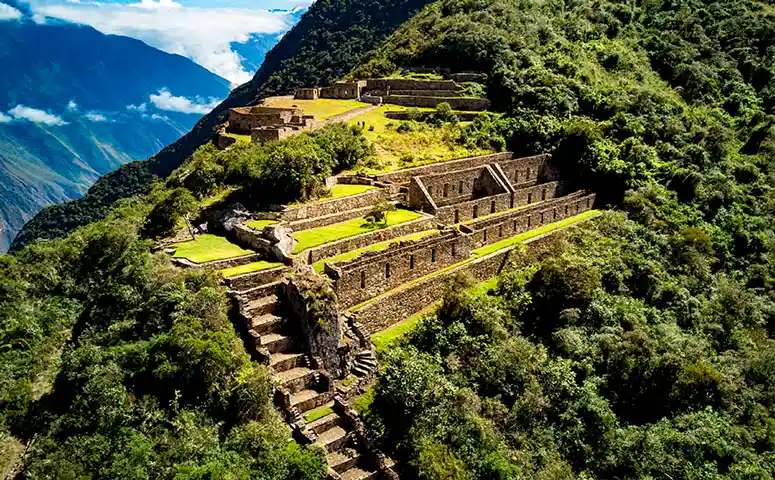
A fascinating adventure to discover an extraordinary place. This phrase captures the experience of exploring and uncovering Choquequirao (3,050 m a.s.l.), an archaeological complex perched high on a mountain in Vilcabamba (Cusco region) that can be reached by foot after crossing the Apurímac River canyon.
At the end of a challenging four-day trek (round trip), starting from the village of Cachora (Abancay, Apurímac), you will arrive at one of the most significant monuments of pre-Hispanic Peru. Often overlooked for centuries, it is said to have been the last refuge of the Incas.
Considered an administrative, religious, agricultural, and defensive centre, its magnificent plazas, temples, homes, and terraces filled with the sun’s energy will recharge you and convince you that your long effort was worthwhile. If you’re an experienced hiker, you can extend your journey to Machu Picchu.
- Location: There is a dispute between the Cusco provinces of La Convención and Anta, both claiming that Choquequirao is located within their territory. The archaeological site is only accessible on foot or by pack animal. From Cachora, the approximate distance is 30 kilometers.
- Opening Hours: Monday to Sunday from 7:00 to 17:00.
- Prices:
- Foreigners: S/ 60.00
- Peruvians: S/ 30.00
- Students: S/ 10.00
Cahuachi
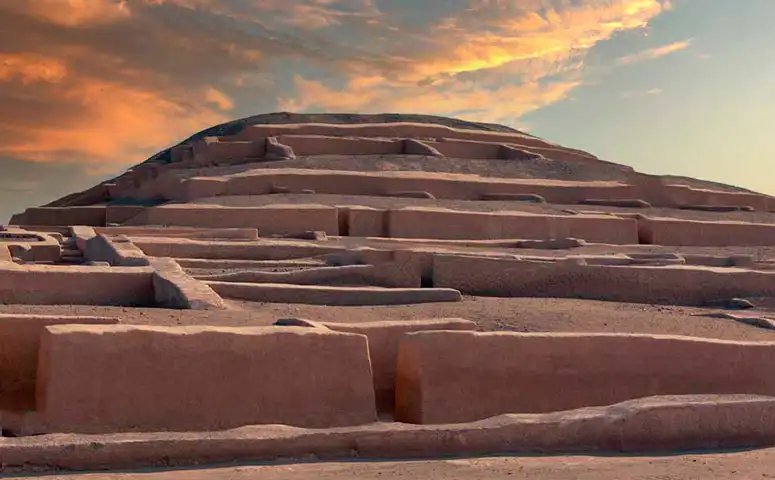
“The place where the seers live” (that’s what its name means in Spanish) was the sacred capital of the Nazca culture, the pre-Hispanic civilization that created the famous lines or geoglyphs, which remain an enigma and a challenge for researchers today.
Cahuachi, located in the valley of the Nasca River and 28 km northwest of the city of the same name, was the site of agricultural and funerary rituals. This is evidenced by the ceremonial mounds and the Great Temple, composed of terraces that rise up a natural hill to a height of 30 m.
In this sacred capital, there are no signs of urban or residential areas. Researchers believe that pilgrims participating in the rituals slept in tents or temporary shelters set up in “the place where the seers live.”
- Location: In the valley of the Nasca River, 28 kilometers northwest of the city of Nasca (Ica region).
- Opening Hours: Monday to Sunday from 9:00 to 16:00.
- Prices: Entry is free.
Moray
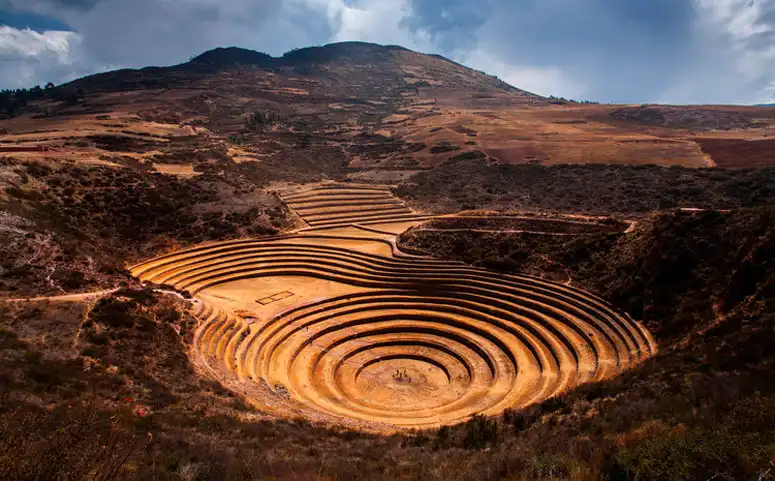
Not a city, fortress, temple, or waystation, Moray, at 3,385 m a.s.l., is an archaeological site that will amaze you with its extraordinary circular agricultural terraces, constructed by the Incas for crop experimentation and research.
Located in the district of Maras (Urubamba province, Cusco), Moray served as an agricultural laboratory, ingeniously designed to create microclimates. The goal was to plant various types of crops to assess their adaptation, growth, and productivity under different environmental conditions.
The depth and strategic orientation of the terraces in relation to the wind and sun create astonishing temperature differences (up to 15 °C between the top and the bottom of the depressions), providing an ideal environment for experimentation.
- Location: 7 kilometers from the town of Maras (Urubamba province) and 66 kilometers from Cusco.
- Opening Hours: Monday to Sunday from 7:00 to 18:00
- Prices: Entry to Moray is included in both types of Cusco Tourist Ticket.
- Foreigners: S/ 130.00 (integral ticket) / S/ 70.00 (partial ticket)
- Peruvians: S/ 70.00 (integral ticket) / S/ 40.00 (partial ticket)
Pikillacta
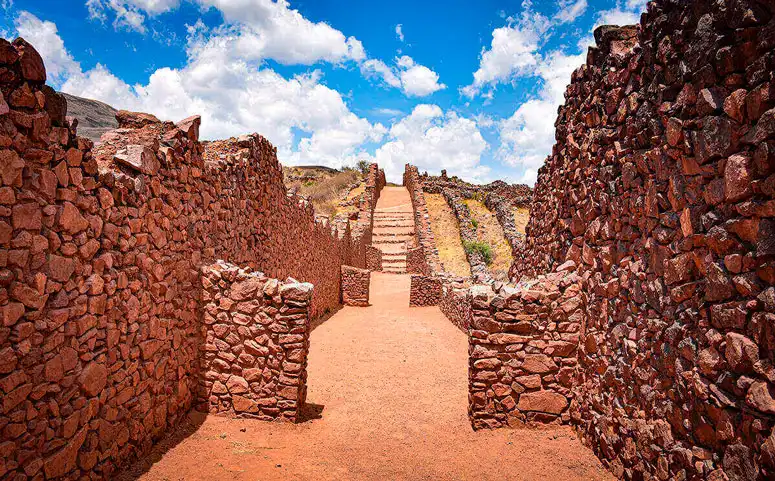
Before the rise of the Incas in what is now the district of Oropesa (Quispicanchi province, Cusco), the Wari civilization—considered the first imperial structure of the Andes—constructed a city made of stone and adobe that housed over 10,000 people.
Pikillacta, meaning “The Town of Fleas” in Spanish, is notable for its walls that rise up to 12 meters high. Be sure to take the opportunity to visit Rumicolca, one of the “gates” to Cusco, where entry and exit to the “navel of the world” were controlled.
- Location: In the district of Oropesa, Quispicanchi province, 30 kilometers southeast of Cusco.
- Opening Hours: Monday to Sunday from 8:30 to 16:30.
- Prices: Entry to Pikillacta is included in both types of Cusco Tourist Ticket.
- Foreigners: S/ 130.00 (integral ticket) / S/ 70.00 (partial ticket)
- Peruvians: S/ 70.00 (integral ticket) / S/ 40.00 (partial ticket)
Puruchuco
Before the arrival of the conquistadors and the Spanish foundation of Lima, there existed in the current metropolis an administrative and ceremonial center of the Ichma culture called Puruchuco. Between 1438 and 1533, this archaeological heritage, known for its fabulous adobe and stone structures, was under Inca control.
Truncated pyramids, plazas, food storage facilities, and a complex water storage and distribution system shape the urban and monumental geography of Puruchuco, located on Cerro Mayorazgo in the Ate district, east of Metropolitan Lima.
Make sure to visit the Arturo Jiménez Borja Site Museum, which displays a wide variety of artifacts and pieces that provide insight into the daily life and religious practices of the ancient inhabitants—a rich perspective on pre-Hispanic Lima.
- Location: Cerro Mayorazgo, Avenida Javier Prado 8579, Ate district, Metropolitan Lima.
- Opening Hours: Tuesday to Sunday from 9:00 o 17:00.
- Prices:
- Adults: S/ 5.00
Raqchi
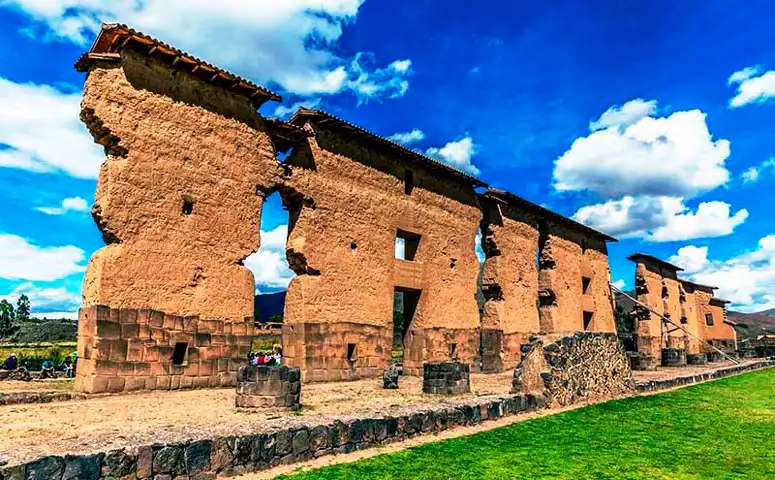
The Temple of Wiracocha is the main structure of this archaeological site in the district of San Pedro de Cachas (Canchis province, Cusco region). Its large walls and columns showcase the faith and respect for one of the most important deities of ancient Peru.
Raqchi was constructed progressively by Inca rulers, and within its approximately one thousand hectares, you will find aqueducts, underground tombs, and 156 colcas—circular structures used for storing food, which was consumed during times of scarcity.
Before returning to Cusco, explore the Site Museum, where you’ll see an interesting collection of artifacts and pieces found during archaeological excavations. This material will provide you with a broader understanding of the history, culture, and significance of Raqchi in the Tawantinsuyo.
- Location: In the district of San Pedro de Cachas, Canchis province, 119 kilometers from Cusco.
- Opening Hours: Monday to Sunday from 7:00 to 18:00.
- Prices:
- Adults: S/ 10.00
- Students: S/ 5.00
Vilcashuamán
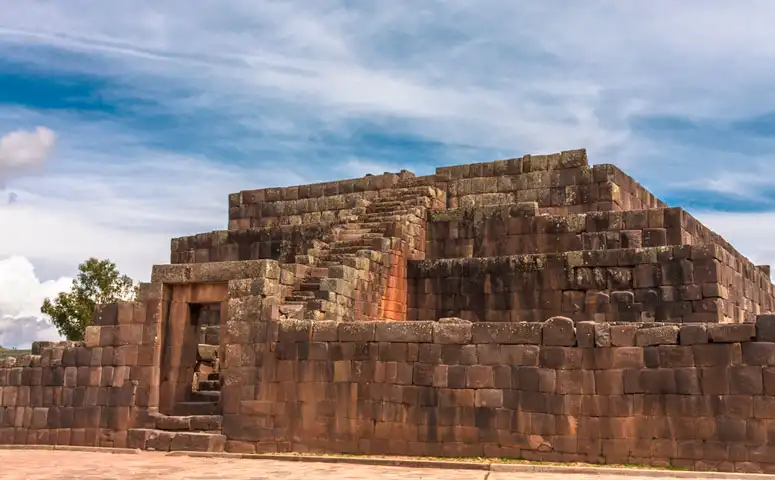
The Inca Empire solidified in the Andes after the Cusco forces defeated the Chancas, a fierce and warlike people. Following their victory, the “Sons of the Sun” expanded their territories and constructed a grand ceremonial and administrative center in Vilcashuamán.
Located in the province of the same name (150 kilometers from Ayacucho), Vilcashuamán, meaning “Sacred Falcon” in Spanish, dazzles visitors with the majesty of its main plaza, the Temple of the Sun, and the Ushnu, a ceremonial pyramid that once featured a stone throne believed to have been covered in gold.
Due to its strategic position, Vilcashuamán (3,490 m a.s.l.) served as a crucial point on the Qhapan Ñan, the great road of the Incas that connected various regions of the Tawantinsuyo. During your visit, you’ll be drawn to the colonial church of San Juan Bautista, built on the stones of the archaeological site.
- Location: 150 kilometers from Ayacucho, the capital of the region of the same name.
- Opening Hours: Monday to Sunday from 8:00 to 17:00.
- Prices:
- Adults: S/ 7.00
Huaca Rajada
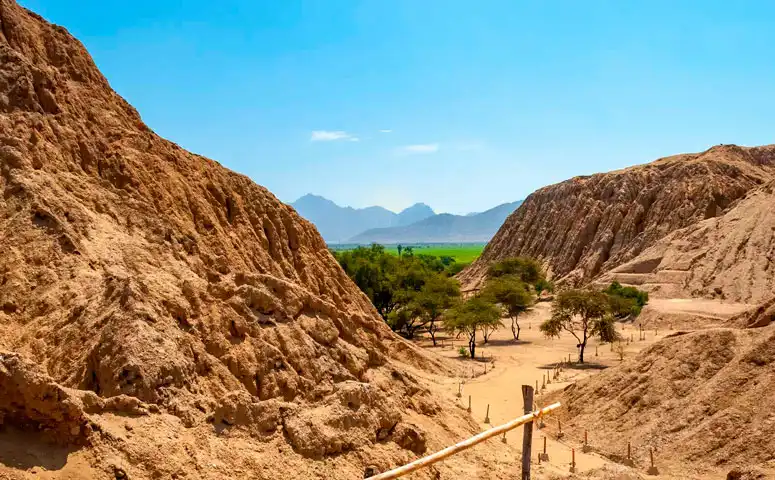
In 1987, Peruvian archaeologist Walter Alva discovered the intact tomb of a Moche ruler, a pre-Hispanic civilization that thrived in northern Peru. Due to the significance and magnitude of the find, the discovery of the so-called Lord of Sipán had a tremendous impact on the global scientific community.
At the Huaca Rajada in the village of Sipán (Chiclayo province, Lambayeque region), there are three funerary pyramids, with the smallest giving its name to this historical site. This pyramid is characterised by the deep cracks that erode its sides.
In the archaeological zone, you will find a Site Museum. Within its halls, you will gain a broader understanding of Moche culture and the magnificent funerary treasures of the Lord of Sipán. You will also learn about the other tombs uncovered by researchers, which shed light on a piece of the past in the northern coast.
If you wish to delve deeper into the Moche civilization, take some time to visit the Royal Tombs of Sipán Museum in Lambayeque. During your visit, you will fully appreciate the importance of Alva’s discovery and can admire the funerary offerings of the pre-Hispanic dignitary.
- Location: In the district of Saña. The distance from Chiclayo, the capital of the Lambayeque region, is 30 kilometres.
- Hours: Monday to Sunday from 9:00 to 17:00.
- Prices:
- Adults: S/ 8.00
- Higher education students: S/ 3.00
Q’enqo
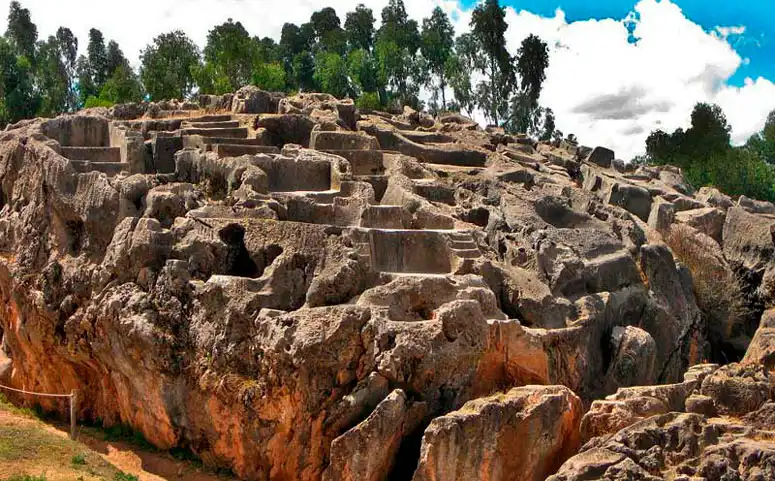
A semi-circular platform surrounded by niches, underground galleries, channels, and a chamber for ceremonies related to uku pacha, the world below or the realm of the dead, is what you will see when visiting Q’enqo, one of the main areas of the Saqsaywaman Archaeological Park.
Q’enqo, one of the most popular tourist attractions due to its proximity to the Historic Centre of Cusco, is believed to have been a space dedicated to mortuary rituals. Here, bodies were embalmed, and through a ritual, it was determined whether a person had led a virtuous life.
In the “labyrinth”—the Spanish translation of Q’enqo—you’ll find a forest of eucalyptus trees, a species not native to the Andes but quite common in high-altitude areas. Take advantage of the location to capture stunning photographs that are sure to be a hit on social media.
- Location: It is located 4 kilometres from the Historic Centre of Cusco, within the Saqsaywaman Archaeological Park.
- Opening Hours: Monday to Sunday from 8:00 to 17:00.
- Prices: Entry to Q’enqo is included in both options of the Cusco Tourist Ticket.
- Foreigners: S/ 130.00 (full ticket) / S/ 70.00 (partial ticket).
- Peruvians: S/ 70.00 (full ticket) / S/ 40.00 (partial ticket).
Huaca de la Luna
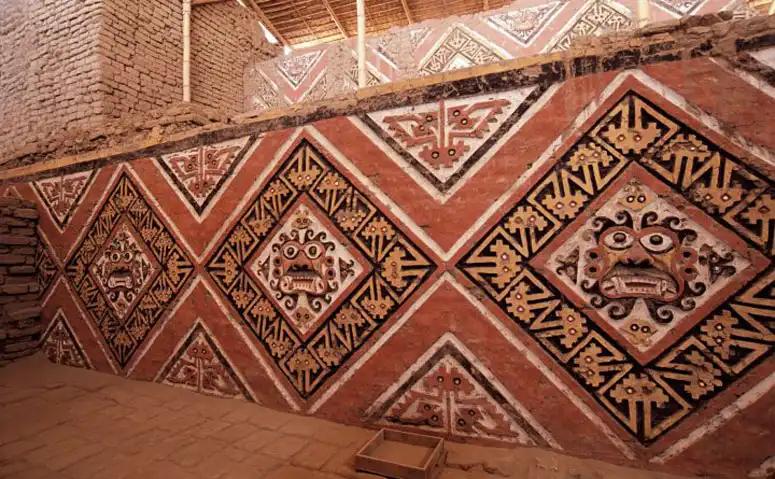
In the Moche Valley, just five kilometres south of Trujillo, the capital of the La Libertad region, stands a pyramid-like temple where human sacrifices are believed to have taken place. This is the prevailing theory, supported by the discovery of the remains of 40 warriors at this archaeological site.
With a base measuring 87 metres and a height of 21 metres, the huaca features impressive platforms and interconnected chambers linked by corridors and ramps. Many of these spaces are adorned with polychrome murals depicting various motifs and characters from Moche iconography.
At the Huaca de la Luna—alongside the Huaca del Sol, remnants of Cerro Blanco, the ancient capital of the Moche—you’ll be struck by the representation of the fearsome god Ai Apaec (the Decapitator), a supernatural deity associated with fertility, power, and war.
- Location: It is located 5 kilometres south of Trujillo, the capital of the La Libertad region.
- Opening Hours: Monday to Sunday from 9:00 to 15:00.
- Prices:
- Adults: S/ 10.00
- University students and seniors: S/ 5.00
- Children: S/ 1.00
Tambo Colorado
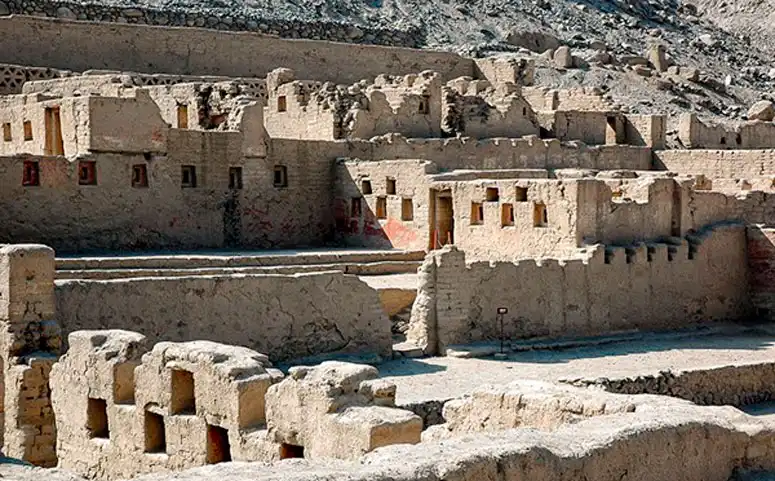
Along an ancient path that connected the coast to the highlands, the Incas established an administrative centre. Known also as Puka Tampu, Pukallaqta (Red Town), or Pukawasi (Red House), this archaeological site features adobe blocks instead of stone, giving it a unique character.
The main buildings of Tambo Colorado (located in the Pisco province, Ica) are arranged around a central plaza. Given its characteristics, this Inca enclave on the Peruvian coast is believed to have been an administrative and ceremonial centre, built during the peak of the political, economic, and social power of the “Children of the Sun” empire.
Easily accessible from the Los Libertadores highway (which connects Pisco to Ayacucho), its name comes from the reddish colour of its walls, although they also display other pigments (blacks, whites, yellows, and ochres).
If you have time and are eager to keep exploring, extend your visit to the Huaytará archaeological site (in the Huancavelica region), located 72 kilometres from Tambo Colorado (via Los Libertadores).
- Location: Tambo Colorado is situated in the Humay district (Pisco province, Ica region). The distance from the centre of Pisco to the archaeological site is 47 km.
- Opening Hours: Monday to Sunday from 9:00 to 17:00.
- Prices:
- Adults: S/ 8.00
- Children: S/ 1.00
